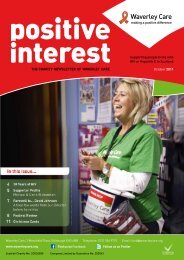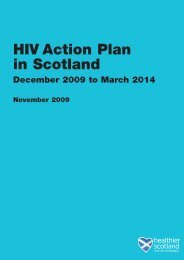I want to be like the others - Waverley Care
I want to be like the others - Waverley Care
I want to be like the others - Waverley Care
- No tags were found...
You also want an ePaper? Increase the reach of your titles
YUMPU automatically turns print PDFs into web optimized ePapers that Google loves.
I <strong>want</strong> <strong>to</strong> <strong>be</strong> <strong>like</strong> <strong>the</strong> o<strong>the</strong>rsQualitative StudyThe study identified a range of stakeholders with knowledge and insight in<strong>to</strong> <strong>the</strong>needs of children infected and affected by HIV in Scotland. Those included:• Practitioners from health and voluntary sec<strong>to</strong>r HIV agencies• Parents and carers• Children and young people infected with HIV• Children and young people affected by parental HIVIn <strong>to</strong>tal, 48 people contributed <strong>to</strong> <strong>the</strong> qualitative part of <strong>the</strong> study: 20 practitionersfrom voluntary sec<strong>to</strong>r HIV agencies and NHS services in Edinburgh, Glasgow,Dundee and A<strong>be</strong>rdeen, as well as 28 adults and children in Edinburgh and Glasgow.Of <strong>the</strong>se, 16 were parents and carers, five were children and young people infectedwith HIV and seven were children and young people affected by parental HIV. Mostinterviews were with individuals or occasionally with two practitioners <strong>to</strong>ge<strong>the</strong>r. Onegroup interview was also held in Glasgow with parents and carers.Key findings from practitioners• With <strong>the</strong> exception of health services, HIV agencies in Scotland are focused onadults; where services for children exist, <strong>the</strong>se have <strong>to</strong> <strong>be</strong> accessed throughadults first.• All <strong>the</strong> agencies currently working with children and HIV would <strong>like</strong> <strong>to</strong> <strong>be</strong> able <strong>to</strong>do more for children. Additionally, two high profile children’s charities (Barnardo’sand Children in Scotland) which had <strong>be</strong>en active in <strong>the</strong> field of children and HIV in<strong>the</strong> past are no longer involved in this area, <strong>be</strong>cause of difficulties in funding thiswork.• Agencies work a great deal with o<strong>the</strong>rs in <strong>the</strong> field, and with external voluntaryand statu<strong>to</strong>ry agencies. However, practitioners noted that inter-agencycollaboration was made difficult by pressures on agencies, particularly healthcareagencies. Concern for confidentiality may also impede collaboration: serviceusers from one agency may not <strong>want</strong> <strong>to</strong> <strong>be</strong> referred <strong>to</strong> ano<strong>the</strong>r for specialistsupport due <strong>to</strong> fear of stigma.• Practitioners identified <strong>the</strong> importance of offering safe, non-threatening services<strong>to</strong> children infected and affected by HIV, particularly given <strong>the</strong> stigma whichsurrounds HIV.• They also felt that more needs <strong>to</strong> <strong>be</strong> done across-<strong>the</strong>-board <strong>to</strong> highlight <strong>the</strong>issues faced by children in relation <strong>to</strong> HIV (e.g. in schools and in health boards,especially those with low num<strong>be</strong>rs of infected adults).vⅰivii











